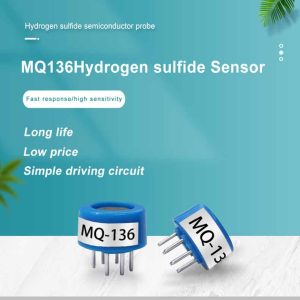Indoor air quality (IAQ) has a significant impact on our health, comfort, and overall well-being. Poor IAQ can lead to various health issues, including respiratory problems, allergies, and even long-term chronic diseases. To ensure a healthy indoor environment, gas sensors have emerged as essential tools for monitoring and managing IAQ. This article explores the role of gas sensors in indoor air quality monitoring, highlighting their importance in promoting healthier living spaces.

Understanding Indoor Air Quality:
Indoor air quality refers to the condition of the air within buildings, including homes, offices, schools, and other enclosed spaces. It is influenced by factors such as ventilation, temperature, humidity, and the presence of pollutants. Common indoor pollutants include volatile organic compounds (VOCs), carbon dioxide (CO2), carbon monoxide (CO), particulate matter, and various gases emitted from building materials, cleaning products, and human activities.
The Need for Gas Sensors:
Gas sensors play a crucial role in IAQ monitoring by detecting and measuring the concentration of various gases and pollutants present in indoor environments. Traditional methods of IAQ assessment relied on manual sampling and laboratory analysis, which were time-consuming and expensive. Gas sensors provide real-time and continuous monitoring capabilities, enabling immediate detection of harmful gases and facilitating prompt corrective actions.
Detecting Volatile Organic Compounds (VOCs):
VOCs are organic chemicals that easily evaporate at room temperature, releasing harmful gases into the air. They are commonly found in paints, adhesives, cleaning agents, and furnishings. Gas sensors equipped with VOC detectors can identify and measure the concentration of these compounds, helping to identify potential sources of pollution and allowing for targeted mitigation strategies. By monitoring VOC levels, occupants can be alerted to high concentrations and take steps to reduce exposure.
Monitoring Carbon Dioxide (CO2) Levels:
Carbon dioxide is a natural byproduct of human respiration and is also emitted by various combustion processes. High levels of CO2 indicate poor ventilation, which can lead to drowsiness, headaches, and reduced cognitive function. Gas sensors that measure CO2 levels provide valuable information about indoor air circulation and ventilation effectiveness. This data can guide building operators and occupants in adjusting ventilation systems and improving IAQ.
Ensuring Combustion Safety:
Gas sensors are indispensable in detecting potentially dangerous gases like carbon monoxide (CO), which is produced by incomplete combustion of fuels such as gas, oil, or wood. CO is a colorless and odorless gas that can be lethal in high concentrations. By integrating CO sensors into IAQ monitoring systems, early detection of CO leaks or faulty combustion appliances can be achieved, preventing potential health hazards and ensuring the safety of occupants.
Particulate Matter Monitoring:
Particulate matter (PM) consists of tiny particles suspended in the air, including dust, pollen, mold spores, and other allergens. High levels of PM can trigger respiratory problems, allergies, and worsen existing conditions such as asthma. Gas sensors equipped with PM detectors help monitor and measure the concentration of these particles, allowing for effective filtration and ventilation strategies to improve IAQ and reduce health risks.
Data Analysis and Insights:
Gas sensors generate vast amounts of data, but the true value lies in analyzing this data to gain insights into IAQ trends and patterns. Advanced algorithms and data analytics techniques enable the identification of correlations between pollutant levels, occupancy patterns, and ventilation efficiency. This information can guide building managers and occupants in making informed decisions to optimize IAQ and create healthier living environments.
Promoting Occupant Awareness and Behavior Change:
Gas sensors not only provide valuable data but also raise awareness among occupants about the importance of IAQ. Real-time monitoring and visible displays of pollutant levels can encourage behavior changes, such as reducing the use of certain products or adjusting ventilation practices. This increased awareness empowers individuals to take an active role in maintaining healthier indoor environments.

Regulatory Compliance and Certification:
Gas sensors play a crucial role in meeting regulatory requirements and obtaining certifications related to IAQ standards. Many countries and organizations have established guidelines and thresholds for various pollutants. Gas sensors enable continuous monitoring, ensuring compliance with these standards and facilitating the certification process for buildings and indoor spaces.
Conclusion:
Gas sensors are indispensable tools in the quest for healthier indoor environments. By detecting and measuring the concentration of gases and pollutants, thes
 : +86 155 8830 2704
: +86 155 8830 2704 : jxdziot@gmail.com
: jxdziot@gmail.com
